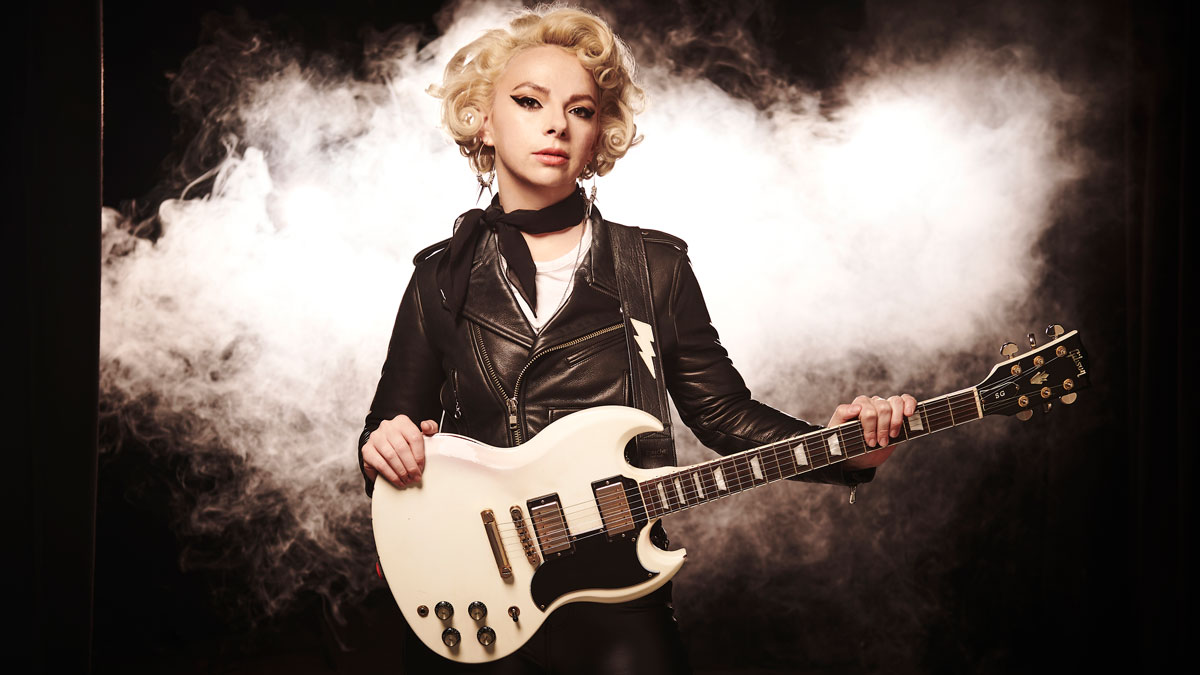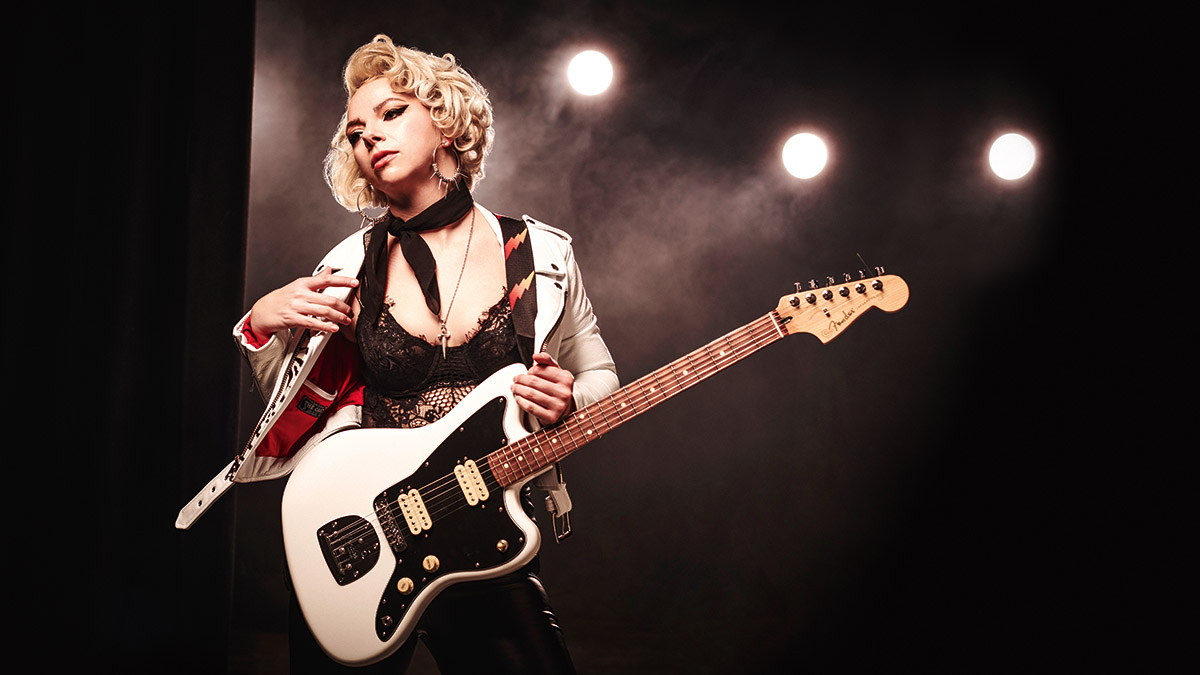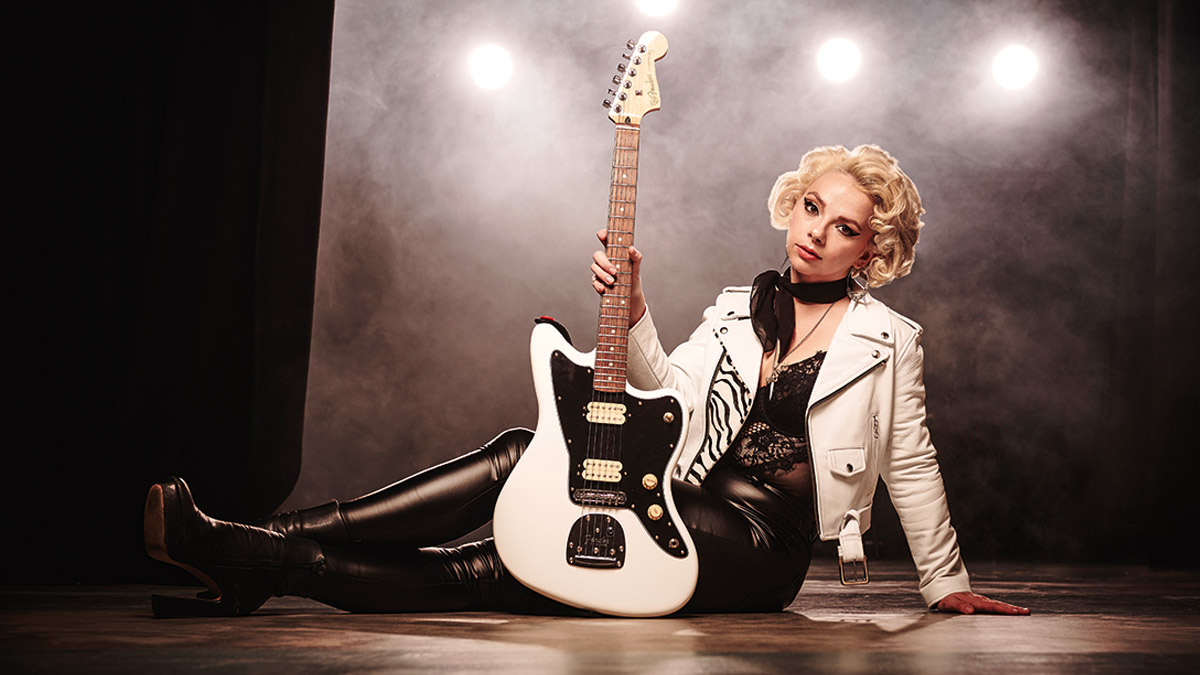Samantha Fish: “I play other guitars, but I always go back to the SG because it fights me just enough. I need something to push back a little bit and she does”
The blues-rock ace on what draws her to both Gibson and Fender, why all guitar players should learn drums, and how she ended up using an elementary school PA system for her tones on her new album with Jesse Dayton, Death Wish Blues

Samantha Fish was in the middle of a UK tour when she dropped by Guitarist’s studios at the end of last year. She was eager to talk about the ominously titled Death Wish Blues, her newest project that sees her teaming up with US Americana guitarist Jesse Dayton.
The album features some of Samantha’s grittiest performances to date, replete with her Gibson SG-fuelled guitar playing and stunningly soulful vocals. The tour was going well, apart from her having to undertake some running repairs to her road‑weary cigar-box guitar, but thankfully gaffer tape saved the day once again.
As we settled down to chat, she revealed the guitar wasn’t her first instrument. In fact, she joins the ranks of players like Eddie Van Halen and Nuno Bettencourt who also started their journeys in music with the drums. We find out more…
What made you switch from drums to the guitar?
“In my house, when I was growing up, the drums were stationary and they were in the basement. To be honest, I was kind of scared of my basement – it was creepy. I don’t know, it’s just there was something about the guitar. I could pick it up and I could go outside and I could sit on the grass and I could be wherever.
If you pick up the drums first, it’s going to instil a metronome within you and you’re going to learn about groove. It’s the building block of everything
“I started lessons on drums when I was 13 and I don’t think I had the discipline at that point because, when you’re going every week, they’re giving you lesson plans and all of a sudden you have homework. I think, for me at that time, it stopped being fun and creative and it became just another part of my homework that I had to do.
“When I found the guitar, it was like a little bit of freedom. But I love the drums and I honestly encourage everybody to learn how to play drums if you’re into music. If you pick up the drums first, it’s going to instil a metronome within you and you’re going to learn about groove. It’s the building block of everything.”
Get The Pick Newsletter
All the latest guitar news, interviews, lessons, reviews, deals and more, direct to your inbox!
What sort of music were you listening to back in those early days?
“I grew up listening to the radio and you couldn’t really find many FM stations except for classic rock. And then there’s country music and maybe public radio, but I hadn’t discovered that yet. So I was really heavily into Mike Campbell, Tom Petty and the Heartbreakers, The Rolling Stones, AC/DC. Anything that just smashed.”
Did you get into bands at school?
“No, I kind of kept that whole part of my life really separate. In school I was really shy, nobody even knew that I played! When we graduated I did some kind of senior project and I wrote a little song and I gave a performance for the class, which was totally out of character because I couldn’t even give a book report without getting a panic attack, essentially. So I just kept it to myself.”
What made you finally choose to go pro?
“When I graduated high school I started to want to go out and perform. We had a lot of jams in Kansas City, so every night of the week there was some kind of sit-in you could go to. I would go out and meet different players. You start getting into the scene and all of a sudden it’s like, ‘Hey, do you want to go play a gig with me?’ And I put my crew together and I started having a full calendar. That’s how I did it, just pulling from the scene of Kansas City and making it happen.”

Death Wish Blues sounds like a doomy title…
“Dark, I know. But it’s really cool. I haven’t done a collaborative record since Girls With Guitars [with Cassie Taylor and Dani Wilde], which was 12 years ago. Jesse and I split the songwriting, we did some duets, some of the songs are mine, some are Jesse’s. He’s amazing, he’s from Texas, but he plays an incredible range of music.
“He’s kind of known for Americana and outlaw country, but he was a big part of the Rob Zombie films The Devil’s Rejects and [House of] 1000 Corpses; he was in those movies, he was the house band. So he spans quite a lot of genres between rock ’n’ roll and country. We came together to make this kind of ‘alt-blues’ record.
“I think blues is a cornerstone of my playing, for sure, and we explored songwriting together. It’s an interpersonal exchange, but it rocks and it’s fun. It’s like a party on a record, you know?”
So the new album was a departure for you?
“I’ve never done a duet record, so it was cool to embrace this dynamic where it’s not just me singing songs about my experiences. Now I have this counterpart and it definitely was a little different. But what I really liked about working with Jon Spencer, the producer [from the Jon Spencer Blues Explosion], is he’s really good at producing vocals in a way that I’ve never experienced before.
“He takes on vocals like an acting exercise. Some producers will be like, ‘Hey, try to hit this note again…’ like it’s about the technique. Jon takes it from the perspective of acting, and I can hear a lot of attitude in the vocals. I think he really pushed us in a way to get the most emotive performance possible. And you can really hear that on this record.”
You have to be really in a calm state and be open to creativity coming to you. So I do collaborate a lot, just to facilitate creativity and keep things moving
Is this kind of collaboration a new experience for you in recent years, then?
“To be honest, I collaborate a lot. I’m a touring musician so my schedule is always on the go. Sometimes it’s hard to compartmentalise that and sit down and open the creativity valve.
“So if I’m ever feeling stuck, I’ll call up a friend or a writing partner and say, ‘Hey, let’s get together and work on something,’ and that really gets things churning. Whereas I might sit down by myself and just be too stressed. You have to be really in a calm state and be open to creativity coming to you. So I do collaborate a lot, just to facilitate creativity and keep things moving.”
In the interim you’ve released an EP, The Stardust Sessions, with Jesse.
“Yeah, it’s very raw, very rock ’n’ roll and loose. We recorded three songs that are covers, one by The Clash [Brand New Cadillac], one by Magic Sam [Feelin’ Good] and one by Townes Van Zandt [I’ll Be Here In The Morning]. We did that as a run-up to introduce people to this concept of Jesse and I doing an original album and a tour together.”
What gear did you take into the studio with you for Death Wish Blues?
“My SG, I used that a lot. I brought in a Jaguar and my cigar-box guitar. Then I brought my pedalboard in, but I really didn’t need it because Jon had some of the coolest gear in the studio. We went up to Woodstock, New York, and they had so many cool little amps in the studio.
“We used some vintage Tweed Fender Deluxes, a Kay amp, a Magnatone M15, a Kustom 200 head through some speaker cabinets – which sounded crazy – and an Airline amplifier. And a lot of my rhythm guitar was done on this repurposed, deconstructed PA system that they used for the Woodstock Elementary School back in the day. They kind of inherited this gear at Applehead studios and it was definitely funky and weird.”
What about the pedals that you used?
“Well, my favourite one – and it’s kind of broken, of course – is the Analog Man King of Tone. I have one of the originals and so I don’t want to part with it. I don’t want to get a new one because it won’t be what I have. Half of the channels are broken, but it has a really nice gain boost on it. So I did use that a little bit.
“Mostly, though, when I’m in the studio, unless I’m trying to get a weird fuzz – for which I use a JHS Mini Foot Fuzz – I like to use the amp and the tubes and I like to just kind of dime it and see what that sounds like. A lot of times when I go into the studio, I don’t use a ton of pedals, especially if I’m laying down a rhythm track. Just let the amp do the work.”
I’ve always loved how Angus Young and Derek Trucks can make an SG work. It’s versatile, you can make it sound aggressive, I can get some dynamic things out of it
What’s the attraction for the SG?
“I don’t even know, honestly. I bought it back in 2015 right before the Chills & Fever record and I’d been playing my custom guitar that [Mike] Delaney had built for me – a woodgrain thinline T-Style – and I just wanted something monochromatic. I’ve always loved how Angus Young and Derek Trucks can make an SG work.
“It’s versatile, you can make it sound aggressive, I can get some dynamic things out of it and, honestly, it just fits my hands really well. I feel at home on it. I play other guitars, too, but I always go back to that one because it feels like it fights me just enough. I need something to push back a little bit and she does, just a perfect amount.”

What about the Jazzmaster you’ve brought with you on this tour?
“The Jazzmaster is cool, too. I’m finding it’s a little more precious on the road. It’s because of the way the saddle is and all that – you’re constantly having to adjust it. It’s not like, ‘Throw it in a box and roll halfway across the world and go’ – it requires a little more love and tenderness. But I will say when you plug it in the thing just has so much gas.”
And, of course, there’s your famous cigar-box guitar.
“When I go to the show, if I don’t pull it out, people go, ‘Cigar box!’ You know, I killed it on the last tour. I did something to it, I messed up the wiring and I couldn’t fix it on the road. The other day I was playing it and I literally pushed down so hard the back piece where the strap was attached completely broke in half; I mean, I completely broke the guitar in half.
“So we taped it back together and it works just fine… but it’s taped together. And people in the front row are like, ‘Cigar box! Where is it?’ And I’m like, ‘It’s broken!’ They want to hear it, they want to see it. I think it’s become something that I’m known for. And that one’s tone; I’ve played other cigar boxes and they don’t sound like that one. So I like mine. But it’s like carrying around a cracker or a biscuit. It’s super-fragile.”
- Death Wish Blues is out now via Rounder.
With over 30 years’ experience writing for guitar magazines, including at one time occupying the role of editor for Guitarist and Guitar Techniques, David is also the best-selling author of a number of guitar books for Sanctuary Publishing, Music Sales, Mel Bay and Hal Leonard. As a player he has performed with blues sax legend Dick Heckstall-Smith, played rock ’n’ roll in Marty Wilde’s band, duetted with Martin Taylor and taken part in charity gigs backing Gary Moore, Bernie Marsden and Robbie McIntosh, among others. An avid composer of acoustic guitar instrumentals, he has released two acclaimed albums, Nocturnal and Arboretum.
“I suppose I felt that I deserved it for the amount of seriousness that I’d put into it. My head was huge!” “Clapton is God” graffiti made him a guitar legend when he was barely 20 – he says he was far from uncomfortable with the adulation at the time
“I was in a frenzy about it being trapped and burnt up. I knew I'd never be able to replace it”: After being pulled from the wreckage of a car crash, John Sykes ran back to his burning vehicle to save his beloved '76 Les Paul











